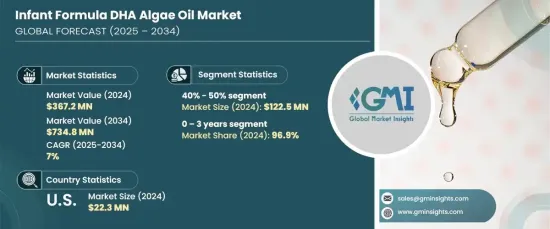
세계의 유아용 조제분유 DHA 조류 오일 시장은 2024년에는 3억 6,720만 달러에 달하며, 2025-2034년 CAGR은 7%로 견고한 성장을 보일 것으로 예측됩니다.
이러한 성장은 중요한 오메가 3 지방산인 DHA와 관련된 다양한 건강상의 이점에 대한 인식이 높아졌기 때문입니다. 소비자들이 건강한 식습관을 우선시하는 경향이 지속되면서 DHA가 풍부한 유아용 조제분유, 건강기능식품, 기능성 식품 등 DHA가 풍부한 제품들이 빠르게 인기를 끌고 있습니다. 특히 부모들은 자녀의 두뇌와 시력의 최적 발달을 위해 DHA 강화 제품에 대한 수요가 급증하고 있습니다. 또한 식물성 DHA 공급원, 특히 해조류 오일의 가용성이 높아지면서 지속가능성과 환경에 대한 인식이 높아지는 추세와 맞물려 소비자들의 관심이 더욱 높아지고 있습니다. 이러한 식물성 DHA에 대한 선호는 오일 추출 기술의 발전과 함께 시장의 지속적인 확장을 보장하고 있습니다.

DHA 조류 오일 시장은 DHA 농도에 따라 30%-40%와 40%-50%의 두 가지 주요 카테고리로 나뉩니다. 농도 40%-50% 부문이 가장 큰 시장으로 2024년 1억 2,250만 달러의 매출을 기록할 것으로 예상됩니다. 또한 DHA 함량이 높은 우유를 선택하는 부모들이 늘어나면서 가장 빠르게 성장하고 있는 분야이기도 합니다. DHA가 인지, 시력, 면역계 건강, 특히 어린이 발달 초기에 중요한 역할을 한다는 인식이 확산되면서 이러한 수요를 촉진하고 있습니다. 부모들은 그 어느 때보다 더 많은 정보를 얻고 있으며, 자녀에게 가장 효과적인 영양 지원을 제공하기 위해 의식적인 결정을 내리고 있습니다.
| 시장 범위 | |
|---|---|
| 시작연도 | 2024년 |
| 예측연도 | 2025-2034년 |
| 시작 금액 | 3억 6,720만 달러 |
| 예상 금액 | 7억 3,480만 달러 |
| CAGR | 7% |
시장 세분화에는 0-3세, 3-6세, 미숙아 및 고령아를 포함한 기타 연령대도 포함되며, 0-3세 부문은 2024년 96.9%의 점유율을 차지하며 시장을 장악하고 있으며, 지속적으로 빠르게 성장하고 있습니다. 영유아의 두뇌 발달, 시각 건강, 면역 체계 강화에 필수적인 특정 영양 요구사항이 있는데, DHA 강화 조제분유는 이러한 요구사항을 충족하는 데 필수적인 역할을 하며, DHA 강화 조제분유에 대한 인식이 높아짐에 따라 DHA 강화 조제분유에 대한 수요는 급증할 것으로 예상됩니다. 급증할 것으로 예상됩니다.
미국에서는 2024년 유아용 조제분유에 함유된 DHA 조류 오일 시장이 2,230만 달러 규모에 달했습니다. 이러한 성장을 지원하는 것은 유아 조제분유에 DHA 함유를 의무화하는 FDA 및 WHO의 권고와 같은 규제 프레임워크입니다. 또한 유아기 발달에 있으며, DHA의 중요성에 대한 부모들의 이해도가 높아지면서 프리미엄 조제분유에 대한 선호도가 증가하고 있습니다. 높은 가처분 소득 수준과 E-Commerce와 같은 유통 경로의 발달로 인해 미국 소비자들은 이러한 제품을 더 쉽게 접할 수 있게 되었습니다.
The Global Infant Formula DHA Algae Oil Market was valued at USD 367.2 million in 2024, with projections indicating a robust CAGR of 7% from 2025 to 2034. This growth can be largely attributed to a growing awareness of the numerous health benefits associated with DHA, a crucial omega-3 fatty acid. As consumers continue to prioritize healthier dietary choices, products enriched with DHA, such as infant formulas, dietary supplements, and functional foods, are rapidly gaining popularity. Parents are particularly keen on ensuring optimal brain and vision development for their children, leading to a surge in demand for DHA-enriched products. Furthermore, the increasing availability of plant-based DHA sources, particularly algae oil, has further driven consumer interest, as it aligns with the growing trend of sustainability and environmental consciousness. This preference for plant-based DHA, alongside advancements in oil extraction technology, ensures the market's continued expansion.

The DHA algae oil market is segmented by DHA concentration into two primary categories: 30%-40% and 40%-50%. The 40%-50% concentration segment is the largest, generating USD 122.5 million in 2024. It is also the fastest-growing segment, with an increasing number of parents opting for formulas with higher DHA content. This demand is driven by a stronger recognition of DHA's vital role in cognitive, visual, and immune system health, particularly during the early stages of a child's development. Parents are more informed than ever, making conscious decisions to provide their children with the most effective nutritional support possible.
| Market Scope | |
|---|---|
| Start Year | 2024 |
| Forecast Year | 2025-2034 |
| Start Value | $367.2 Million |
| Forecast Value | $734.8 Million |
| CAGR | 7% |
Market segmentation also includes age groups such as 0-3 years, 3-6 years, and other groups, which include premature infants and older children. The 0-3 years segment dominated the market with a share of 96.9% in 2024, and it continues to see the fastest growth. Infants and toddlers have specific nutritional needs that are crucial for brain development, visual health, and immune system strengthening. DHA-enriched formulas play an integral role in meeting these needs, and as awareness of these benefits increases, the demand for DHA-infused infant formulas is set to soar.
In the U.S., the market for DHA algae oil in infant formulas accounted for USD 22.3 million in 2024. This growth is supported by regulatory frameworks, such as recommendations from the FDA and WHO, which require the inclusion of DHA in infant formulas. Additionally, parents' growing understanding of DHA's importance in early childhood development has led to increased adoption of premium formulas. High disposable income levels, coupled with well-established distribution channels, including e-commerce, have made these products more accessible to American consumers.